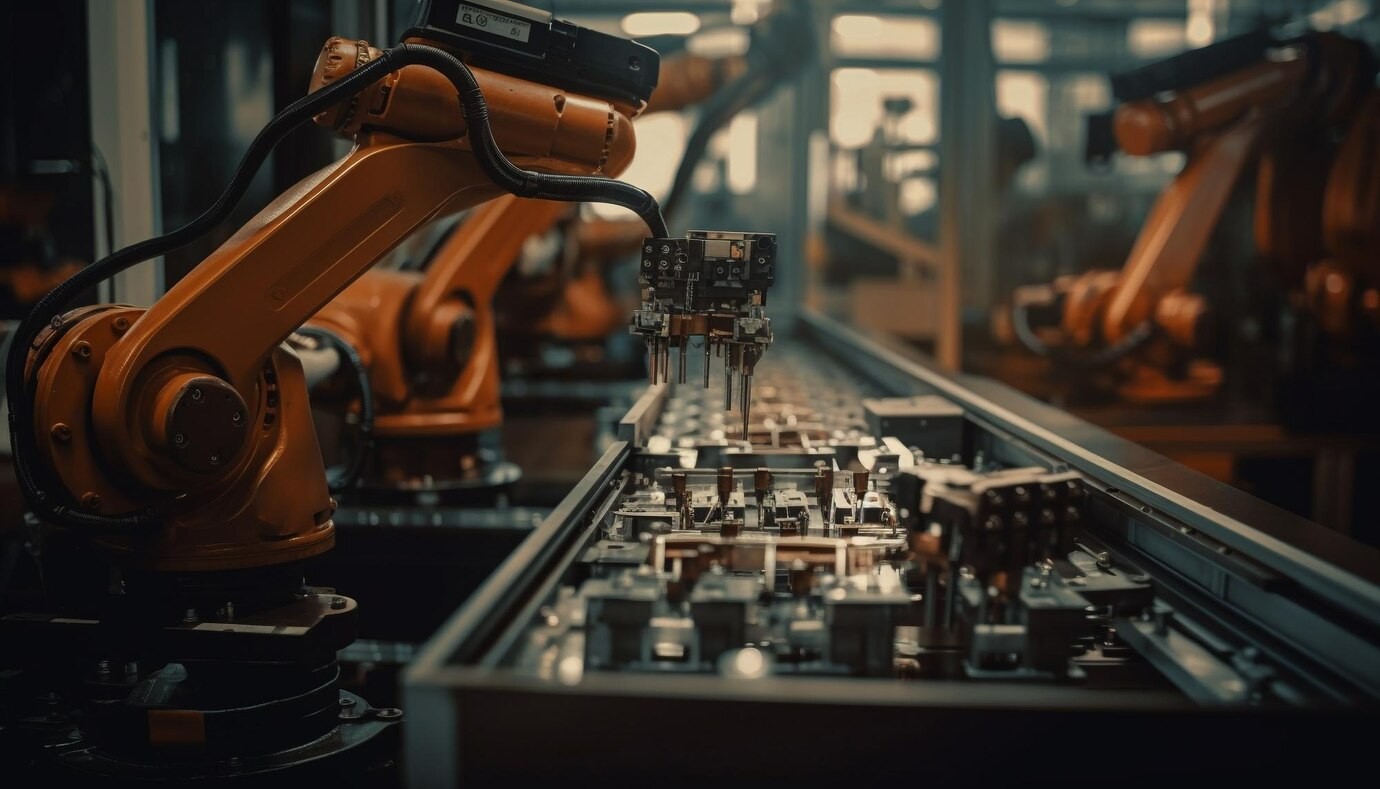An Overview:
The manufacturing landscape is profoundly transforming in an era of digital innovation and Industry 4.0. Microfactories, compact powerhouses reshaping traditional manufacturing norms, are at the forefront of this revolution. Microfactories represent a paradigm shift in manufacturing, emphasising agility, precision, and adaptability. Defined by their smaller scale and advanced technologies, these facilities respond to the demands of a rapidly changing market. By integrating smart technologies and data-driven processes, Microfactories redefine the manufacturing ecosystem, unlocking new possibilities for industries worldwide.
The concept of microfactories has picked up in the last five years, with several players establishing microfactories in various industries. Several new innovative start-ups have embraced this concept, challenging the traditional way of manufacturing.
The table below provides an overview of the difference between traditional manufacturing facilities and microfactories:
| Feature |
Traditional Manufacturing Facility |
Microfactory |
|
Scale
|
Large-Scale |
Small-Scale |
| Scope |
A broad range of products |
Single product or small range |
| Production Process |
High automation, standardised |
Flexible combination of automation and human labour |
| Location |
Centralised hubs |
Closer to customer markets |
| Distribution |
Wholesalers & retailers |
Direct-to-consumer, regional focus |
| Sustainability |
High environmental footprint |
Lower environmental footprint |
| Capital Investment |
Substantial |
Lower initial investments |
| Production Speed |
Longer lead times for product development and changes to production processes |
Quicker product development cycles and shorter lead times |
| Technology Integration |
Rely on established manufacturing technologies |
Leverage advanced manufacturing technologies |
The Microfactory Market has experienced robust growth in recent years, with a compound annual growth rate (CAGR) exceeding expectations.
The global microfactory market is expected to grow from $2.4 Bn in 2022 to $12.2 Bn in 2030, with a CAGR of around 24% from 2023 to 2030. This exponential expansion is driven by the demand for customised, small-batch production and the integration of cutting-edge technologies.
Market Dynamics:
Market Drivers
The growth of the microfactory market is driven by several key factors that contribute to its increasing adoption and expansion.
Here are some prominent growth drivers for the microfactory market:
- Increasing Demand for Customization: The increasing demand for personalised and customised products is a significant driver for microfactories. These facilities excel in producing small batches of highly tailored goods, meeting the preferences of individual consumers.
- Emergence of Agile Manufacturing: Microfactories enable agile manufacturing, allowing companies to adapt to changing market demands quickly. The ability to shift production processes rapidly and efficiently is crucial in today's dynamic business environment.
- Rising Industry 4.0 Adoption: Microfactories are pivotal in the broader Industry 4.0 revolution. Integrating smart technologies such as IoT, robotics, and automation enhances efficiency, reduces downtime, and optimises production processes.
- Increasing focus on Sustainability: As sustainability becomes a key focus for industries, microfactories contribute to eco-friendly manufacturing practices. Their efficient resource utilisation and reduced environmental footprint align with the growing emphasis on sustainable business operations.
- Need for Resilient Supply Chain Operations: Microfactories offer a level of supply chain resilience by reducing dependence on extensive global supply chains. This is particularly relevant during disruptions, such as those caused by global events or geopolitical factors.
- Market Demand for Small-Batch Production: The growing market demand for niche markets and speciality products aligns well with the capabilities of microfactories. These facilities are adept at producing small quantities of unique or customised items that cater to specific consumer segments.
- Government Initiatives and Incentives: Governments and regulatory bodies recognising the potential of microfactories may implement policies and incentives to promote their adoption. This can include grants, tax incentives, or other supportive measures encouraging businesses to invest in microfactory technologies.
Market Challenges
While the microfactory market offers numerous opportunities and advantages, it has challenges and constraints. Understanding these obstacles is crucial for industry stakeholders to navigate effectively.
Here are some key challenges and restraints for the microfactory market:
- Limited Scalability: Microfactories, by their nature, have limited production capacities compared to larger-scale manufacturing facilities. Scaling up to meet higher production demands can be challenging, particularly for industries with mass production requirements.
- High Initial Investment: Implementing advanced technologies such as robotics, automation, and IoT in microfactories requires a significant initial investment. This cost can be a barrier for small and medium-sized enterprises (SMEs) adopting microfactory solutions.
- Skill Shortages: The operation of microfactories often requires a skilled workforce capable of handling advanced technologies. Workforce training and development to meet the demands of these technologies can be a hurdle for companies transitioning to microfactory models.
- Cybersecurity Risks: Integrating IoT and connectivity in microfactories increases the risk of cybersecurity threats. Protecting sensitive data and intellectual property and ensuring the security of connected systems are critical challenges for microfactory operators.
- Infrastructure Requirements: Existing manufacturing facilities may require significant adaptations or renovations to accommodate microfactory technologies. This can be logistically challenging and may incur additional costs.
- Lack of Awareness and Adoption: Limited awareness and understanding of microfactory capabilities may hinder widespread adoption. Educating industries about the benefits and potential applications of microfactories is crucial for market growth.
- Reluctance to Shift from Traditional Manufacturing: Traditional manufacturing methods and a reluctance to embrace new technologies can be restraints. Overcoming the inertia of established practices and convincing stakeholders of the advantages of microfactories is an ongoing challenge.
Technological Innovations:
The impact of technology on the microfactory market is profound and transformative, shaping the way manufacturing is conducted in the digital age. Microfactories, empowered by technology, redefine industry standards, offering a more flexible, efficient, and sustainable approach to production in the digital age.
Here are key components of the technological landscape shaping the microfactory market:
- Internet of Things: A network of sensors embedded in machines and throughout the facility gathers real-time data on production processes, inventory levels, and environmental conditions. Microfactories leverage IoT for real-time monitoring and data collection. This data empowers microfactories to make informed decisions and quickly adapt to changing demands. Sensors embedded in machines and production lines provide insights into equipment performance, enabling predictive maintenance and process optimisation.
- Collaborative Robots (Cobots): These smaller, friendlier robots work alongside human workers, handling repetitive tasks like assembly, packaging, and quality control. Cobots are easily programmable and adaptable, ideal for micro-factories and dynamic production lines. Microfactories often deploy cobots that work alongside human operators. These robots enhance precision, speed up processes, and contribute to a more flexible and adaptive manufacturing environment.
- Additive Manufacturing & 3D Printing: This versatile technology allows on-demand production of customised parts and prototypes, reducing lead times and minimising waste. Microfactories can leverage 3D printing for rapid prototyping, producing functional parts, and even creating personalised products. This flexibility is particularly valuable for industries with diverse product requirements.
- Artificial Intelligence & Machine Learning (AI/ML): AI-powered systems monitor equipment performance and predict potential failures, enabling preventative maintenance and minimising downtime. This is crucial for microfactories' lean operations. AI algorithms and machine learning models are employed for predictive maintenance, quality control, and demand forecasting in microfactories. ML algorithms analyse production data to identify inefficiencies and recommend improvements. This data-driven approach optimises resource allocation, reduces waste, and enhances productivity.
- Digital Twin: A digital twin for micro-factories is a virtual representation of the physical micro-factory and its processes. It incorporates real-time data from sensors, IoT devices, and other sources to create a comprehensive, dynamic model. Microfactories often implement digital twin technology, creating virtual replicas of physical systems. This allows for simulation, modelling, and testing of production processes before implementation, minimising risks and optimising efficiency.
- Green & Sustainable Technologies: Microfactories increasingly adopt sustainable materials and processes to reduce their environmental footprint. This includes using recycled materials, minimising energy consumption, and employing closed-loop manufacturing systems. Microfactories often integrate energy-efficient solutions and renewable energy sources to align with sustainability goals. Smart energy management systems contribute to reduced environmental impact.
- Nanotechnology: Nanotechnology has the potential to bring about significant advancements in microfactories, enabling more precise and efficient manufacturing processes. Nanotechnology allows for the creation of smaller and more precise components, enabling the miniaturisation of devices and systems within microfactories. This is particularly beneficial for micro-scale manufacturing processes. Nanomaterials possess unique properties that can enhance the performance of materials used in microfactories. For example, nanocomposites can be stronger, lighter, and more durable than traditional materials, improving efficiency and product quality.
Emerging Use Cases:
Microfactories are finding diverse applications across various industries, showcasing their adaptability and efficiency in meeting specific production needs.
Here are emerging use cases of microfactories with real-world examples:
- Electronics Manufacturing: Microfactories are well-suited for producing small electronic components and IoT devices. This includes sensors, microcontrollers, and other electronics used in smart home devices, wearables, and industrial IoT applications. Xerox's PARC (Palo Alto Research Center) utilises microfactory principles for producing printed electronic components, demonstrating the application in developing advanced sensor technologies.
- Medical Device Production: Microfactories can produce custom medical devices and implants on demand. This includes dental prosthetics, orthopaedic implants, and other patient-specific healthcare solutions. Invisalign, a system for straightening teeth, uses micro-factory principles to produce custom 3D-printed aligners for patients, demonstrating micro-factories application in the healthcare industry.
- Automotive Components: Microfactories can play a role in producing specialised or low-volume automotive components. They can also facilitate rapid prototyping and testing of new vehicle designs and features. Ford has embraced microfactories for niche production. Their Redford Racing facility in Michigan uses a microfactory model to produce limited-edition performance vehicles like the GT, catering to a specific customer segment and allowing for greater customisation options.
- Aerospace & Defence Components: Microfactories can produce small batches of aerospace components, contributing to the maintenance and repair of aircraft. This includes the production of lightweight, high-performance materials used in aviation. Relativity Space utilises microfactory principles, including large-scale 3D printing, to produce rocket components. This approach enables quick iteration and customisation of rocket designs.
- Consumer Goods & Apparel: Microfactories can manufacture small batches of consumer goods and appliances, allowing companies to respond quickly to changing market demands and produce limited-edition or niche products. Adidas' Speedfactory concept involves microfactories that produce customised and locally relevant sportswear, showcasing the ability to cater to specific consumer preferences.
- Food Production & Processing: In the food industry, microfactories can be used for localised and small-scale production of speciality or gourmet food products. This may include customised chocolates, personalised nutrition bars, or speciality beverages. Cellular agriculture companies like Eat Just use microfactory-like setups to produce lab-grown meat, showcasing the potential for sustainable and customisable food production.
- Pharmaceuticals and Drug Manufacturing: Microfactories in the pharmaceutical industry can produce small batches of personalised medicines and drugs tailored to specific patient needs. This approach, known as personalised or precision medicine, allows for more targeted treatments. MedaPharm, a Swiss company, operates a network of mobile microfactories that can be rapidly deployed to disaster zones or remote areas. These self-contained units produce essential medications on-site, ensuring timely access to life-saving drugs for underserved communities.
Our Perspective:
The future of the Microfactory market lies in continuous innovation. Anticipated advancements include further integrating AI for predictive analytics, enhanced sustainability practices, and developing more user-friendly interfaces. Microfactories are poised for global expansion, with emerging markets recognising the potential benefits of this agile manufacturing approach. We anticipate a broader adoption of Microfactories across diverse industries and geographical regions.
As we look ahead, the role of Microfactories in transforming manufacturing is not just a trend but a fundamental shift in the industry landscape. The ability to deliver customised products efficiently and sustainably positions Microfactories as key players in the digital age of manufacturing. The ongoing synergy between technological innovation, market demand, and regulatory support is set to propel the Microfactory market to unprecedented heights, reshaping the future of manufacturing as we know it. Microfactories are not just a disruptive technology but a paradigm shift in how we think about manufacturing. Their bright future is undeniable, and their potential to reshape industries, empower communities, and create a more sustainable future.
Velox Consultants is one of the fastest-growing market research and strategy consulting firms, recently recognised by Clutch. We specialise in providing customised research reports and Go-to-Market (GTM) strategies that cater to the specific needs of companies across the Manufacturing sectors.
Our team of highly skilled professionals is well-equipped to help your company stay ahead in such a dynamic and competitive market. Explore how microfactories, from large corporations to aspiring entrepreneurs, can revolutionise your business. Please get in touch with us at consult@veloxconsultants.com.





